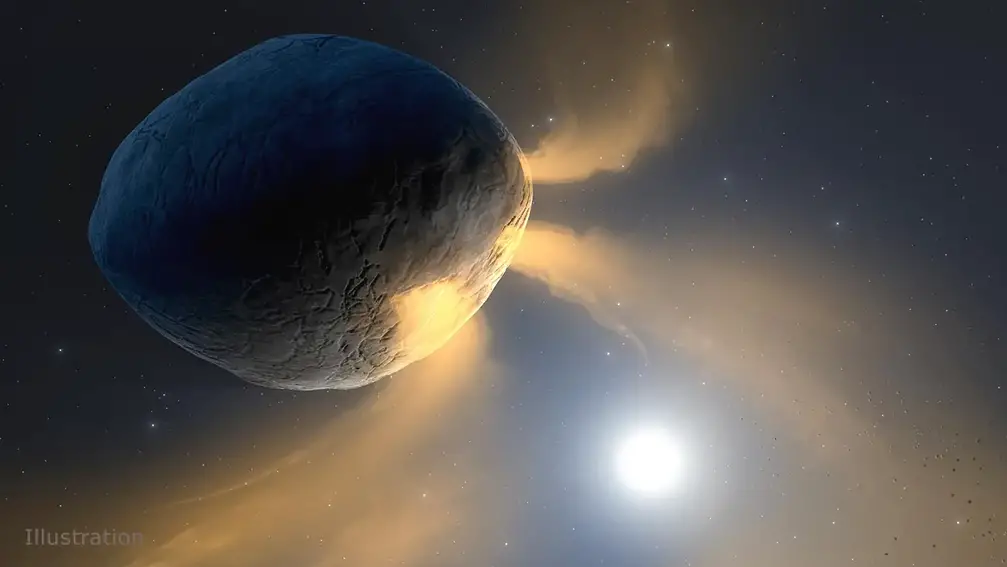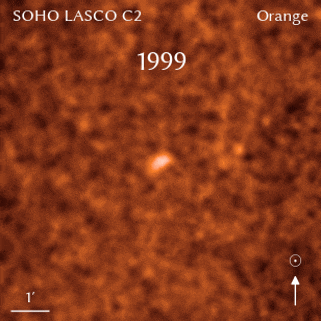This illustration depicts asteroid Phaethon being heated by the Sun. The asteroid’s surface gets so hot that sodium inside Phaethon’s rock may vaporize and vent into space, causing it to brighten like a comet and dislodge small pieces of rocky debris. Credit: NASA/JPL-Caltech/PACIFIC
The SOHO observatory has challenged previous theories about Phaethon, a ‘rock comet’ linked to the Geminid meteor shower, by suggesting that its brightness and tail are caused by sodium emission, not dust release. This discovery also implies that some ‘comets’ might be more similar to rocky asteroids. Future missions and citizen science initiatives aim to further study this intriguing object.
The ESA/NASA SOHO observatory has overturned 14 years of thinking about the strange Sun-skirting ‘rock comet’ known as Phaethon that could reopen the mystery of how the Geminid meteor shower was born.
Every December, the Geminid meteor shower lights up Earth’s skies as our planet plunges through a vast cloud of dust in space. For years, the parent body of this meteor shower was unknown. Most of the annual meteor showers are associated with comets, which leave clouds of dust trailing behind them in the form of their tails. But the Geminids were different: no parent body was obvious.
When Phaethon was discovered in 1983 by the joint US/UK/Netherlands IRAS satellite, astronomers thought the mystery was solved. This small 5.8 km-wide object circled the Sun in an orbit very similar to that of the Geminid dust cloud, providing near-certain proof that Phaethon was the meteor shower’s parent body even though Phaethon was an asteroid, not a comet.
Comparing images of the asteroid Phaethon taken with different filters on SOHO’s LASCO coronograph. On the left, the orange filter reveals the shining asteroid Phaethon with a surrounding cloud and small tail. The brightness of this emission in the orange filter suggests that sodium atoms from the surface of the asteroid fluoresce with an orange glow in response to sunlight, as the asteroid passes close to the Sun at perihelion. On the right, the blue filter shows no sign of Phaethon, indicating that the light emitted is undetectable in this filter. These images were captured in May 2022. Phaethon is thought to be the parent asteroid of the Geminids meteor shower, which illuminates the night sky every December. Credit: ESA/NASA/Qicheng Zhang
Each orbit of Phaethon, lasting 524 days, consists of an unusually close approach to the Sun. At a closest approach (perihelion) distance of 21 million km, Phaethon is hidden from observatories on Earth by the blinding glare of the Sun. Therefore, solar observatories provide the only way to capture vital images to study the extreme activity of the asteroid at perihelion.
Since 2009, the NASA Solar Terrestrial Relations Observatory (STEREO) has observed a sudden brightening of the asteroid a few hours after perihelion. At this close approach, Phaethon also sports a tail, hundreds of kilometers in length, facing away from the Sun. This activity was originally thought to be caused by the release of small dust grains from the cracking of the asteroid’s surface as it passes the Sun. This led to Phaethon being dubbed a ‘rock comet’.
Now, new observations from SOHO recorded in May 2022 have shown for the first time that, contrary to 14 years of previous thought, the emission of sodium atoms is likely responsible for this activity.
A two-hour sequence of the asteroid Phaethon from the perspective of ESA’s SOHO observatory. The images were taken on May 15, 2022, when the asteroid’s orbit ventured close to the Sun, at a distance of 21 million km. The orange filter on the coronagraph LASCO was used to image this asteroid, which is circled in the animation. Credit: ESA/NASA/USNRL/Karl Battams
As part of a special observing plan devised by Qicheng Zhang and Karl Battams, long-exposure, filtered images were taken by SOHO’s Large Angle and Spectrometric Coronagraph (LASCO) telescope. Phaethon and its tail are absent from images taken with LASCO’s blue filter, which can detect dust. But, it is bright in the sodium-sensitive orange filter, offering compelling evidence that sodium emission is occurring. The emission is caused by fluorescence, when sodium atoms get excited by the Sun and glow orange, similar to a street lamp.
“Our unique observing plan found the mysterious asteroid Phaethon for the first time in SOHO data,” says PhD student Qicheng Zhang, who led the study. “The distinctive filters of the 27-year-old LASCO camera were used in a special interruption to the regular observing schedule to uncover these hidden secrets. By digging in the treasure chest of SOHO, we showed that Phaethon is visible in LASCO images from 18 different orbits back to 1997.”
This sequence of images, taken by SOHO’s LASCO coronagraph, depicts the asteroid Phaethon at perihelion during different orbits around the Sun. The glowing asteroid is enveloped by a cloud and followed by a small tail that shines brightly in the orange filter of LASCO. The fluorescence of sodium in response to the Sun causes this brightening.These images were reexamined after LASCO successfully identified Phaethon in images taken in May 2022. The remarkable results show that Phaethon has been observed at perihelion by LASCO for more than 20 years. Credit: ESA
Phaethon is not the only object near the Sun to be releasing sodium. The planet Mercury also exhibits a bright sodium tail that peaks around two weeks after perihelion – something that the joint ESA/JAXA BepiColombo mission will investigate once in orbit around Mercury. Observations of Mercury’s sodium tail from the STEREO H1-1 heliospheric imager were used as a calibration standard, like a standard lamp, to study this emission from Phaethon to support Zhang’s theory.
SOHO has observed hundreds of tiny Sun-skirting objects that are classified as comets – icy bodies which appear to brighten when very close to the Sun. These can be hard to distinguish from asteroids like Phaethon which shine temporarily. However, the sodium identified in this study has opened the possibility that perhaps the so-called comets discovered by SOHO are more like rocky asteroids similar to Phaethon.
This composite image depicts a collection of some of the brightest comets observed by the LASCO coronagraph on the ESA/NASA SOHO observatory. Almost all of these comets were discovered by citizen scientists, who take part in the Sungrazer project. By studying LASCO images, anyone can report new comets and make new discoveries.Although LASCO studies the outer atmosphere of the Sun, known as the corona, it is also a powerful comet hunter. In its 26 years of operation, SOHO has observed over 4500 comets, making it the most successful comet hunter in history. Credit: ESA/NASA/R. Pickard
This study shines more light on the events which could have formed the Geminid meteoroids, which range in size from sand grains to pea-sized. Sodium activity on the surface is not enough to lift these particles and contribute to the stream. Instead, an unobserved and unknown disruption of Phaethon, perhaps over two thousand years ago, is assumed to have created the shower.
The fresh layers of volatile sodium which contribute to the brightening observed today suggest that another mass-loss event may have resurfaced Phaethon more recently, perhaps less than 1000 years ago. Therefore, the exact origin of the Geminids meteoroids may be better understood by studying Phaethon.
There is great interest in Phaethon due to its distinctive activity and mysterious history, which make it an essential and intriguing source of up-close future study. Hence, JAXA is preparing to send a flyby mission called DESTINY+ to image the surface of Phaethon in 2028 and uncover more about its history.
In addition to future missions, citizen scientists can play their part in revealing new discoveries using SOHO. Over 4500 Sun-skirting objects have been identified in SOHO images, the majority with the help of the Sungrazer Project. Citizen scientist ‘comet hunters’ can sift through SOHO and STEREO data to identify new objects.
Karl Battams, principal investigator of both LASCO and the Sungrazer project, explains, “SOHO is the most prominent comet hunter in history, with a huge catalogue of discoveries still awaiting detailed analysis. Both SOHO and STEREO are uniquely placed to be able to routinely observe objects extremely close to the Sun. The future of asteroid and comet studies is bright thanks to these and future encounter missions that will help us uncover more about these dynamic objects.”
“Since its launch in 1995, SOHO and its instruments continue to deliver exciting science, using the mission in different ways to study asteroids and comets in addition to its primary target, the Sun,” adds Bernhard Fleck, ESA’s SOHO project scientist.
For more on this discovery, see Asteroid’s Comet-Like Tail Is Not Made of Dust.
Reference: “Sodium Brightening of (3200) Phaethon near Perihelion” by Qicheng Zhang, Karl Battams, Quanzhi Ye, Matthew M. Knight and Carl A. Schmidt, 25 April 2023, The Planetary Science Journal.DOI: 10.3847/PSJ/acc866
Source: scitechdaily













